| Pages:
1
..
3
4
5 |
Ubya
International Hazard
    
Posts: 1247
Registered: 23-11-2017
Location: Rome-Italy
Member Is Offline
Mood: I'm a maddo scientisto!!!
|
|
highly conjugated, high absorbtion in the visible spectrum
---------------------------------------------------------------------
feel free to correct my grammar, or any mistakes i make
---------------------------------------------------------------------
|
|
|
Practical
Harmless

Posts: 1
Registered: 4-7-2019
Member Is Offline
|
|
Tryptamine from tryptophan
Purified freebase tryptamine from decarboxylation of tryptophan.
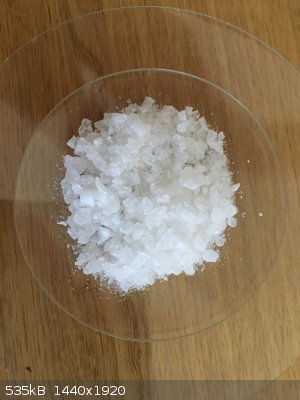
|
|
|
homeschoolmadness
Harmless

Posts: 4
Registered: 3-7-2019
Member Is Offline
|
|
Quote: Originally posted by nimgoldman  | Harmine and harmaline hydrochloride crystals
Harmala alkaloids extracted from Peganum harmala (syrian rue) seeds, further purified by crystallization from brine.
These alkaloids are MAO inhibitors.
I further separate harmine and harmaline (DHH, dihydroharmine), the latter is further reduced to tetrahydroharmine (THH, leptaflorine) which is a weak
SSRI with interesting benefits for central nervous system (could promote neuroplasticity).
I love that an extract from a plant called "rue" can be made into a weak SSRI. Funny.  Though from what I understand, plants usually get "rue" in their common name because they cause hayfever, not because they make people
sad. Two different meanings of "rue," I guess. Though from what I understand, plants usually get "rue" in their common name because they cause hayfever, not because they make people
sad. Two different meanings of "rue," I guess.
https://imgur.com/vhrjqMX
[Edited on 23-3-2019 by nimgoldman] |
|
|
|
Bezaleel
Hazard to Others
  
Posts: 444
Registered: 28-2-2009
Member Is Offline
Mood: transitional
|
|
Molybdenum heteropolyacids are my long-time favorites
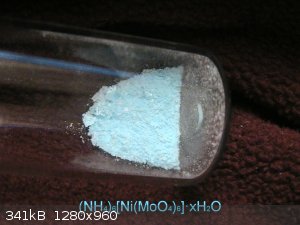
|
|
|
fusso
International Hazard
    
Posts: 1922
Registered: 23-6-2017
Location: 4 ∥ universes ahead of you
Member Is Offline
|
|
Is it really blue? It looks white to me. Can you put it near a white background to make a contrast?
|
|
|
Bezaleel
Hazard to Others
  
Posts: 444
Registered: 28-2-2009
Member Is Offline
Mood: transitional
|
|
Quote: Originally posted by fusso  | | Is it really blue? It looks white to me. Can you put it near a white background to make a contrast? |
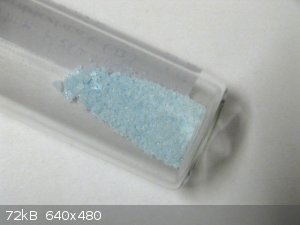
|
|
|
Bezaleel
Hazard to Others
  
Posts: 444
Registered: 28-2-2009
Member Is Offline
Mood: transitional
|
|
Playing with EDTA. Many complexes only seem to exist in solution. The copper-sodium complex retains its deep blue colour when the liquor evaporated,
forming a glassy substance.
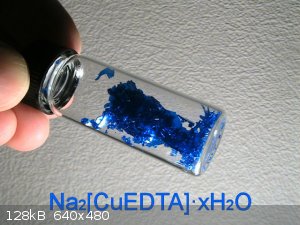
The lithium salt of the copper complex has the same deep blue colour in solution, but crystalises in a cyan-like variant of blue in tiny dull
crystals.
The potassium salt of course has the same colour in solution, but separated into two phases on evaporation of the solution. A dark blue one, and one
with the same colour as the lithium salt.
|
|
|
beta4
Hazard to Self
 
Posts: 56
Registered: 3-2-2019
Member Is Offline
|
|
Crystals of thiourea precipitating from a tin plating solution I made a while ago.
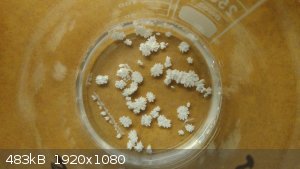
|
|
|
draculic acid69
International Hazard
    
Posts: 1371
Registered: 2-8-2018
Member Is Offline
|
|
Quote: Originally posted by Chem Science  | Hi everyone 
I'm starting !! Mercuric Cyanide Hg(CN)2
Double fun .. toxic mercury .. toxic cyanide ...uses ?? ... no idea realy :/
[Edited on 20-3-2019 by Chem Science] |
Uses? As poison.
|
|
|
Chem Science
Hazard to Others
  
Posts: 123
Registered: 30-7-2018
Location: Argentina
Member Is Offline
|
|
| Quote: |
Hi everyone 
I'm starting !! Mercuric Cyanide Hg(CN)2
Double fun .. toxic mercury .. toxic cyanide ...uses ?? ... no idea realy :/
[Edited on 20-3-2019 by Chem Science]
Uses? As poison.
|
Mercury Cyanide is a very very low dissociation salt. It's used for example to detect Palladium, because Palladium Cyanide has an even less
dissociation constant and its insoluble.
Wiki
The use of mercuric cyanide as an antiseptic was discontinued due to its toxicity. Hg(CN)2 is also used in photography. It is still used in homeopathy
under the Latin name Hydrargyrum bicyanatum.
|
|
|
| Pages:
1
..
3
4
5 |